Module 7 - Introduction to Solid-State Devices and Power Supplies
Pages i ,
1-1,
1-11,
1-21,
1-31,
1-41,
2-1,
2-11,
2-21,
2-31,
2-41,
2-51,
3-1,
3-11,
3-21,
3-31,
3-41,
3-51,
4-1 to 4-10,
4-11,
4-21,
4-31,
4-41,
4-51, Index
Eavg) flows
through the load resistance. This statement can be clarified by using the formula for XC in a
half-wave and full-wave rectifier. First, you must establish some values for the circuit.
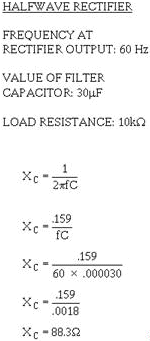
4-21

As you can see from the calculations, by doubling the frequency of the rectifier, you reduce the
impedance of the capacitor by one-half. This allows the ac component to pass through the capacitor more easily. As
a result, a full-wave rectifier output is much easier to filter than that of a half-wave rectifier. Remember, the
smaller the XC of the filter capacitor with respect to the load resistance, the better the filtering
action. Since

the largest possible capacitor will provide the best filtering. Remember, also, that the load resistance
is an important consideration. If load resistance is made small, the load current increases, and the average value
of output voltage (Eavg) decreases. The RC discharge time constant is a direct function of the value of
the load resistance; therefore, the rate of capacitor voltage discharge is a direct function of the current
through the load. The greater the load current, the more rapid the discharge of the capacitor, and the lower the
average value of output voltage. For this reason, the simple capacitive filter is seldom used with rectifier
circuits that must supply a relatively large load current. Using the simple capacitive filter in conjunction with
a full-wave or bridge rectifier provides improved filtering because the increased ripple frequency decreases the
capacitive reactance of the filter capacitor. Q14. What is the most basic type of filter? Q15.
In a capacitor filter, is the capacitor in series or in parallel with the load? Q16. Is filtering better
at a high frequency or at a low frequency? Q17. Does a filter circuit increase or decrease the average
output voltage? Q18. What determines the rate of discharge of the capacitor in a filter circuit?
4-22
Q19. Does low ripple voltage indicate good or bad filtering? Q20. Is a full-wave rectifier
output easier to filter than that of a half-wave rectifier? LC Choke-Input Filter
The LC choke-input filter is used primarily in power supplies where voltage regulation is important and where the
output current is relatively high and subject to varying load conditions. This filter is used in high power
applications such as those found in radars and communication transmitters. Notice in figure 4-19 that this
filter consists of an input inductor (L1), or filter choke, and an output filter capacitor (C1). Inductor L1 is
placed at the input to the filter and is in series with the output of the rectifier circuit. Since the action of
an inductor is to oppose any change in current flow, the inductor tends to keep a constant current flowing to the
load throughout the complete cycle of the applied voltage. As a result, the output voltage never reaches the peak
value of the applied voltage. Instead, the output voltage approximates the average value of the rectified input to
the filter, as shown in the figure. The reactance of the inductor (XL) reduces the amplitude of ripple
voltage without reducing the dc output voltage by an appreciable amount. (The dc resistance of the inductor is
just a few ohms.)

Figure 4-19. - LC choke-input filter. The shunt capacitor (C1) charges and discharges at the ripple frequency rate, but the amplitude of the
ripple voltage (Er) is relatively small because the inductor (L1) tends to keep a constant current
flowing from the rectifier circuit to the load. In addition, the reactance of the shunt capacitor (XC)
presents a low impedance to the ripple component existing at the output of the filter, and thus shunts the ripple
component around the load. The capacitor attempts to hold the output voltage relatively constant at the average
value of the voltage. The value of the filter capacitor (C1) must be relatively large to present a low
opposition (XC) to the pulsating current and to store a substantial charge. The rate of the charge for
the capacitor is limited by the low impedance of the ac source (the transformer), by the small resistance of the
diode, and by the counter electromotive force (CEMF) developed by the coil. Therefore, the RC charge time constant
is short compared to its discharge time. (This comparison in RC charge and discharge paths is illustrated in
4-23
views a and B of figure 4-20.) Consequently, when the pulsating voltage is first applied to the LC choke-input
filter, the inductor (L1) produces a CEMF which opposes the constantly increasing input voltage. The net result is
to effectively prevent the rapid charging of the filter capacitor (C1). Thus, instead of reaching the peak value
of the input voltage, C1 only charges to the average value of the input voltage. After the input voltage reaches
its peak and decreases sufficiently, the capacitor C1) attempts to discharge through the load resistance RL).
C1 will only partially discharge, as indicated in view B of the figure, because of its relatively long discharge
time constant. The larger the value of the filter capacitor, the better the filtering action. However, because of
physical size, there is a practical limitation to the maximum value of the capacitor.
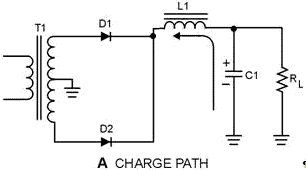
Figure 4-20A. - LC choke-input filter (charge and discharge paths). CHARGE PATH
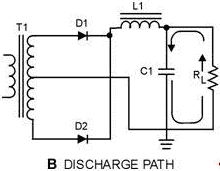
Figure 4-20B. - LC choke-input filter (charge and discharge paths). DIsCHARGE PATH The inductor (also referred to as the filter choke or coil) serves to maintain the current flow to the
filter output (RL) at a nearly constant level during the charge and discharge periods of the filter
capacitor. The inductor (L1) and the capacitor (C1) form a voltage divider for the ac component (ripple) of the
applied input voltage. This is shown in views a and B of figure 4-21. As far as the ripple component is concerned,
the inductor offers a high impedance (Z) and the capacitor offers a low impedance (view B). As a result, the
ripple component (Er) appearing across the load resistance is greatly attenuated (reduced). The
inductance of the filter choke opposes changes in the value of the current flowing through it;
4-24
therefore, the average value of the voltage produced across the capacitor contains a much smaller
value of ripple component (Er) than the value of ripple produced across the choke.
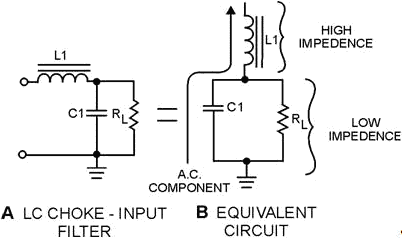
Figure 4-21. - LC choke-input filter. Now look at figure 4-22 which illustrates a complete cycle of operation for a full-wave rectifier
circuit used to supply the input voltage to the filter. The rectifier voltage is developed across the capacitor
(C1). The ripple voltage at the output of the filter is the alternating component of the input voltage reduced in
amplitude by the filter section. Each time the anode of a diode goes positive with respect to the cathode, the
diode conducts and C1 charges. Conduction occurs twice during each cycle for a full-wave rectifier. For a 60-hertz
supply, this produces a 120-hertz ripple voltage. Although the diodes alternate (one conducts while the other is
nonconducting), the filter input voltage is not steady. As the anode voltage of the conducting diode increases (on
the positive half of the cycle), capacitor C1 charges-the charge being limited by the impedance of the secondary
transformer winding, the diode's forward (cathode-to-anode) resistance, and the counter electromotive force
developed by the choke. During the nonconducting interval (when the anode voltage drops below the capacitor charge
voltage), C1 discharges through the load resistor (RL). The components in the discharge path have a
long time constant; thus, C1 discharges more slowly than it charges.
4-25
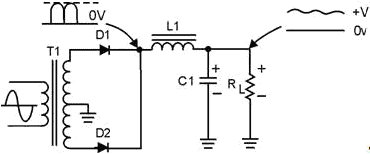
Figure 4-22. - Filtering action of the LC choke-input filter. The choke (L1) is usually a large value, from 1 to 20 henries, and offers a large inductive reactance to
the 120-hertz ripple component produced by the rectifier. Therefore, the effect that L1 has on the charging of the
capacitor (C1) must be considered. Since L1 is connected in series with the parallel branch consisting of C1 and RL,
a division of the ripple (ac) voltage and the output (dc) voltage occurs. The greater the impedance of the choke,
the less the ripple voltage that appears across C1 and the output. The dc output voltage is fixed mainly by the dc
resistance of the choke. Now that you have read how the LC choke-input filter functions, it will be
discussed with actual component values applied. For simplicity, the input frequency at the primary of the
transformer will be 117 volts 60 hertz. Both half-wave and full-wave rectifier circuits will be used to provide
the input to the filter. Starting with the half-wave configuration shown in figure 4-23, the basic
parameters are: With 117 volts ac rms applied to the T1 primary, 165 volts ac peak is available at the secondary
[(117 V) x (1.414) = 165 V]. You should recall that the ripple frequency of this half-wave rectifier is 60 hertz.
Therefore, the capacitive reactance of C1 is:
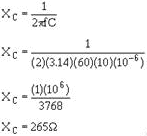
4-26
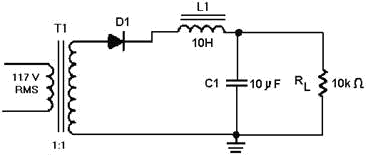
Figure 4-23. - Half-wave rectifier with an LC choke-input filter. This means that the capacitor (C1) offers 265 ohms of opposition to the ripple current. Note, however,
that the capacitor offers an infinite impedance to direct current. The inductive reactance of L1 is:

The above calculation shows that L1 offers a relatively high opposition (3.8 kilohms) to the ripple in
comparison to the opposition offered by C1 (265 ohms). Thus, more ripple voltage will be dropped across L1 than
across C1. In addition, the impedance of C1 (265 ohms) is relatively low with respect to the resistance of the
load (10 kilohms). Therefore, more ripple current flows through C1 than the load. In other words, C1 shunts most
of the ac component around the load. Let's go a step further and redraw the filter circuit so that you can
see the voltage divider action. Refer to view a of figure 4-24. Remember, the 165 volts peak 60 hertz provided by
the rectifier consists of both an ac and a dc component. This first discussion will be about the ac component.
From the figure, you see that the capacitor (C1) offers the least opposition (265 ohms) to the ac component.
Therefore, the greater amount of ac will flow through C1. (The heavy line in view B indicates the ac current flow
through the capacitor.) Thus the capacitor bypasses, or shunts, most of the ac around the load.
4-27
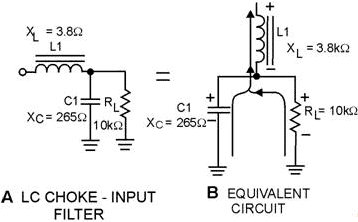
Figure 4-24. - Ac component in an LC choke-input filter. By combining the XC of C1 and the resistance of RL into an equivalent circuit
(view B), you will have an equivalent impedance of 265 ohms. As a formula;

You now have a voltage divider as illustrated in figure 4-25. You should see that because of the
impedance ratios, a large amount of ripple voltage is dropped across L1, and a substantially smaller amount is
dropped across C1 and RL. You can further increase the ripple voltage across L1 by increasing the
inductance (XL
= 2πfL).
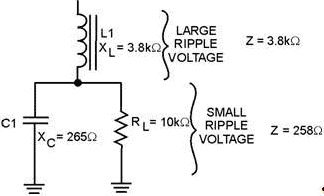
Figure 4-25. - Equivalent circuit of an LC choke-input filter. 4-28
Now let's discuss the dc component of the applied voltage. Remember, a capacitor offers an infinite
(∞) impedance to the flow of direct current. The dc component, therefore, must flow through RL and L1.
As far as the dc is concerned, the capacitor does not exist. The coil and the load are therefore in series with
each other. The dc resistance of a filter choke is very low (50 ohms average). Consequently, most of the dc
component is developed across the load and a very small amount of the dc voltage is dropped across the coil, as
shown in figure 4-26.
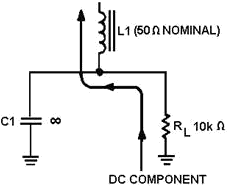
Figure 4-26. - Dc component in an LC choke-input filter. As you may have noticed, both the ac and the dc components flow through L1. Because it is frequency
sensitive, the coil provides a large resistance to ac and a small resistance to dc. In other words, the coil
opposes any change in current. This property makes the coil a highly desirable filter component. Note that the
filtering action of the LC choke-input filter is improved when the filter is used in conjunction with a full-wave
rectifier, as shown in figure 4-27. This is due to the decrease in the XC of the filter capacitor and
the increase in the XL of the choke. Remember, ripple frequency of a full-wave rectifier is twice that
of a half-wave rectifier. For 60-hertz input, the ripple will be 120 hertz. The XC of C1 and the XL
of L1 are calculated as follows:
4-29

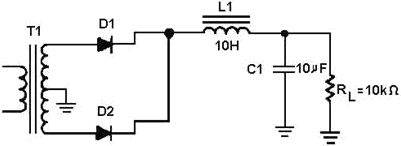
Figure 4-27. - Full-wave rectifier with an LC choke-input filter.
When the XC of a filter capacitor is decreased, it provides less opposition to the flow of ac. The
greater the ac flow through the capacitor, the lower the flow through the load. Conversely, the larger the XL
of the choke, the greater the amount of ac ripple developed across the choke; consequently, less ripple is
developed across the load and better filtering is obtained. Q21. In an LC choke-input filter, what
prevents the rapid charging of the capacitor? Q22. What is the range of values usually chosen for a
choke? Q23. If the impedance of the choke is increased, will the ripple amplitude increase or decrease?
FAILURE ANALYSIs of an LC CHOKE-Input FILTER. - The filter capacitors are subject to open
circuits, short circuits, and excessive leakage; the series inductor is subject to open windings and,
occasionally, shorted turns or a short circuit to the core.
4-30
| - |
Matter, Energy,
and Direct Current |
| - |
Alternating Current and Transformers |
| - |
Circuit Protection, Control, and Measurement |
| - |
Electrical Conductors, Wiring Techniques,
and Schematic Reading |
| - |
Generators and Motors |
| - |
Electronic Emission, Tubes, and Power Supplies |
| - |
Solid-State Devices and Power Supplies |
| - |
Amplifiers |
| - |
Wave-Generation and Wave-Shaping Circuits |
| - |
Wave Propagation, Transmission Lines, and
Antennas |
| - |
Microwave Principles |
| - |
Modulation Principles |
| - |
Introduction to Number Systems and Logic Circuits |
| - |
- Introduction to Microelectronics |
| - |
Principles of Synchros, Servos, and Gyros |
| - |
Introduction to Test Equipment |
| - |
Radio-Frequency Communications Principles |
| - |
Radar Principles |
| - |
The Technician's Handbook, Master Glossary |
| - |
Test Methods and Practices |
| - |
Introduction to Digital Computers |
| - |
Magnetic Recording |
| - |
Introduction to Fiber Optics |
| Note: Navy Electricity and Electronics Training
Series (NEETS) content is U.S. Navy property in the public domain. |
|






















